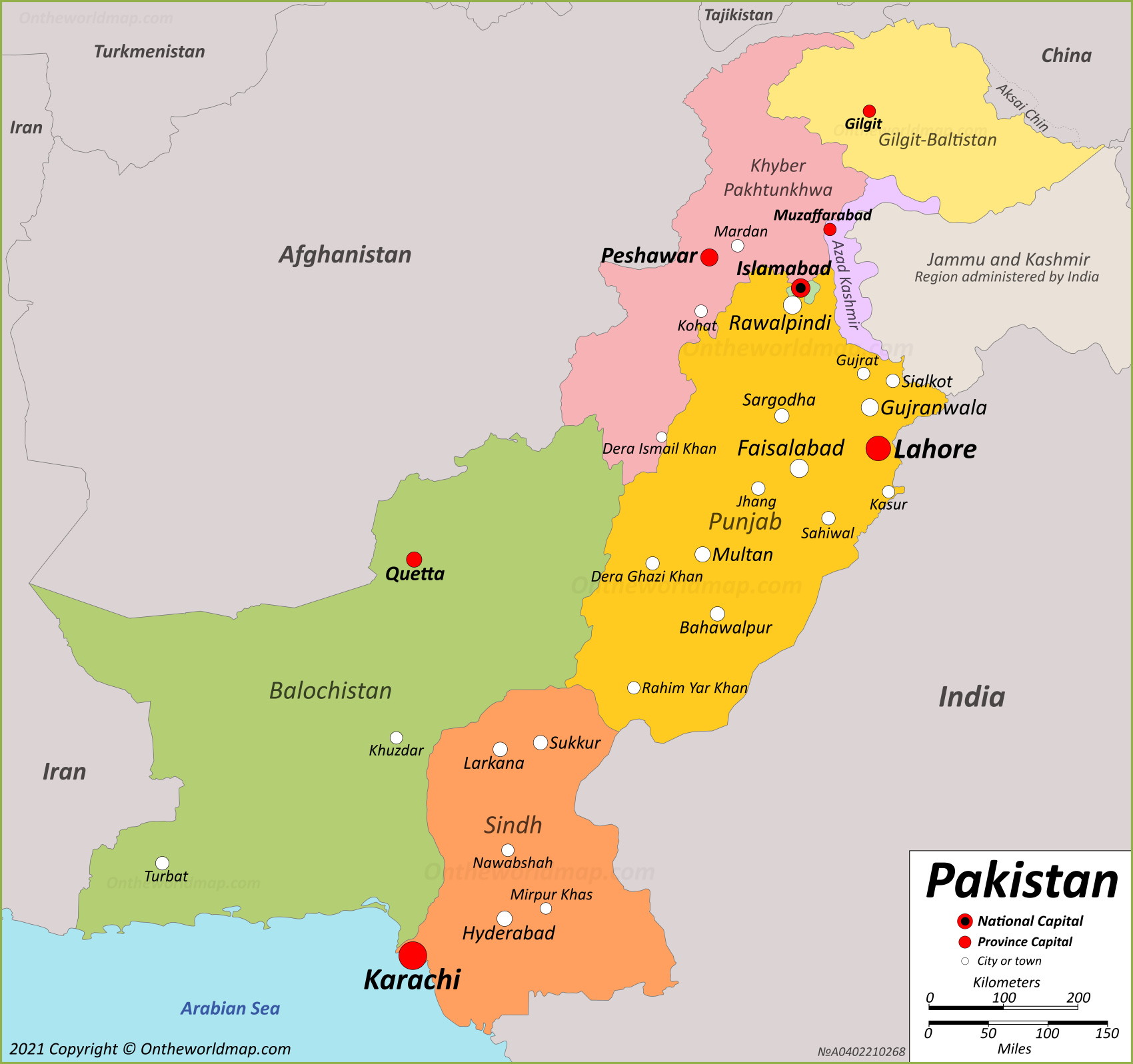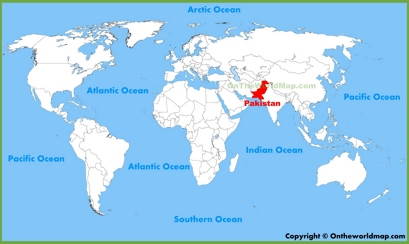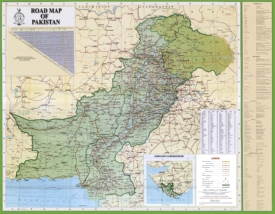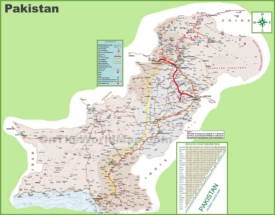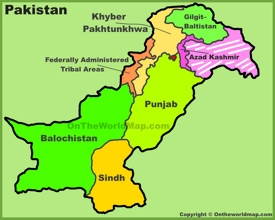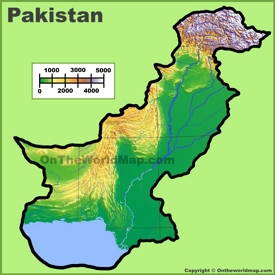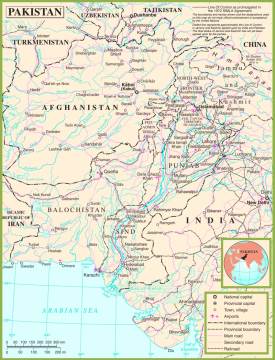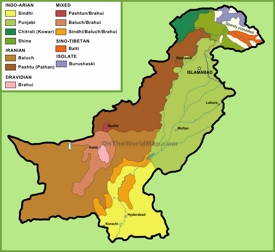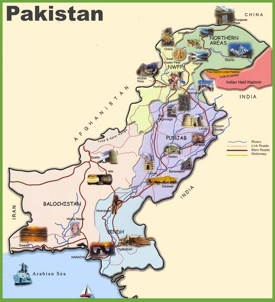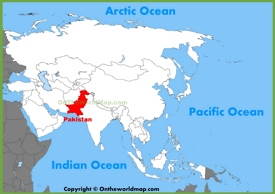Pakistan Map
Description:
This map shows governmental boundaries of countries; provinces, province capital cities, and major cities and towns in Pakistan.
You may download, print or use the above map for educational, personal and non-commercial purposes. Attribution is required. For any website, blog, scientific research or e-book, you must place a hyperlink (to this page) with an attribution next to the image used.
Online Map of Pakistan
About Pakistan
Pakistan, officially the Islamic Republic of Pakistan, occupies a strategic location in South Asia, covering an area of 340,509 square miles (881,913 square kilometers). The country borders Afghanistan to the west, Iran to the southwest, China to the northeast, and India to the east. The Arabian Sea forms Pakistan's southern boundary, providing 650 miles of coastline.
The nation maintains a population of approximately 241 million people (2023 census), making it the world's fifth-most populous country. Islamabad serves as the capital city, while Karachi, with over 16 million inhabitants, functions as the largest city and primary financial center. Other major urban centers include Lahore, Faisalabad, and Rawalpindi.
Pakistan's economy ranks as the 24th largest in the world by purchasing power parity. The country maintains diverse economic sectors, including agriculture, textiles, and manufacturing. Agriculture employs about 39% of the workforce and contributes 19% to the GDP. Pakistan stands among the world's largest producers of cotton, wheat, sugarcane, and rice. The textile industry represents the largest manufacturing sector, accounting for 60% of exports.
The geography encompasses diverse landscapes, from the Himalayan and Hindu Kush mountains in the north to the Arabian Sea coast in the south. K2, the world's second-highest peak at 28,251 feet (8,611 meters), lies within Pakistan's borders. The Indus River and its tributaries form the primary water system, supporting extensive irrigation networks across the country.
Tourism in Pakistan centers on its natural and historical attractions. The country features five UNESCO World Heritage sites, including the ancient ruins of Mohenjo-daro, Taxila, and the Lahore Fort. The Karakoram Highway, often called the "Eighth Wonder of the World," attracts adventure tourists and serves as a crucial trade route connecting Pakistan with China. The northern areas, particularly Gilgit-Baltistan, draw mountaineers and trekkers from around the globe.
The nation possesses significant mineral resources, including coal, copper, natural gas, and salt mines. The Thar Desert contains one of the world's largest coal reserves. Pakistan also maintains a growing technology sector, with major cities developing into IT hubs. The country launched its space program in 1961 and successfully operates several communications satellites.
Pakistan faces various environmental challenges, including water scarcity, deforestation, and air pollution in urban areas. The government has initiated several conservation projects, including the Billion Tree Tsunami program, aimed at increasing forest cover and combating climate change effects.
The Facts:| Flag: |

|
| Capital: | Islamabad |
| Area: | 340,509 sq mi (881,913 sq km) |
| Population: | ~ 241,499,431 (2023 census)[1] |
| Official language: | Urdu, English |
| Religion: |
|
| Ethnic groups: |
|
| Currency: | Pakistani rupee (₨) (PKR) |
| Driving side: | Left |
| Calling code: | +92 |
| Internet TLD: | .pk |
| Time zone: | UTC+05:00 (PKT) |
| Gross domestic product (PPP) (2024 estimate): |
|
| Gross domestic product (nominal) (2024 estimate): |
|
| Official government website: | www.pakistan.gov.pk |
Google Map of Pakistan
List of Largest Cities in Pakistan
| City | Population | Province |
|---|---|---|
| Karachi | 18,868,021 | Sindh |
| Lahore | 13,004,135 | Punjab |
| Faisalabad | 3,691,999 | Punjab |
| Rawalpindi | 3,357,612 | Punjab |
| Gujranwala | 2,511,118 | Punjab |
| Multan | 2,215,381 | Punjab |
| Hyderabad | 1,921,275 | Sindh |
| Peshawar | 1,905,975 | Khyber Pakhtunkhwa |
| Quetta | 1,565,546 | Balochistan |
| Islamabad | 1,108,872 | Islamabad Capital Territory |
| Sargodha | 975,886 | Punjab |
| Sialkot | 911,817 | Punjab |
| Bahawalpur | 903,795 | Punjab |
| Jhang | 606,533 | Punjab |
| Sheikhupura | 591,424 | Punjab |
| Gujrat | 574,240 | Punjab |
| Sukkur | 563,851 | Sindh |
| Larkana | 551,716 | Sindh |
| Sahiwal | 538,344 | Punjab |
| Okara | 533,693 | Punjab |
| Rahim Yar Khan | 519,261 | Punjab |
| Kasur | 510,875 | Punjab |
| Dera Ghazi Khan | 494,464 | Punjab |
| Wah Cantonment | 400,733 | Punjab |
| Mardan | 368,302 | Khyber Pakhtunkhwa |
| Nawabshah | 363,138 | Sindh |
| Burewala | 361,664 | Punjab |
| Mingora | 361,112 | Khyber Pakhtunkhwa |
| Hafizabad | 318,621 | Punjab |
| Chiniot | 318,165 | Punjab |
Main sights in Pakistan
- Lahore Fort
- Shah Jahan Mosque
- Rohtas Fort
- Noor Mahal
- Archaeological Ruins at Moenjodaro
- Taxila
- Takht-i-Bahi
- Shalimar Gardens
- Makli Necropolis
- Rohtas Fort
- Badshahi Mosque
- Wazir Khan Mosque
- Tomb of Jahangir
- Tomb of Bibi Jawindi
- Tomb of Shah Rukn-e-Alam
- Central Karakoram National Park
- Hingol National Park
- Hiran Minar
- Katas Raj Temples
- Hunza Valley
Administrative Units of Pakistan
| Administrative Unit | Capital | Area | Population |
|---|---|---|---|
| Azad Jammu and Kashmir | Muzaffarabad | 13,297 | 4,045,366 |
| Balochistan | Quetta | 347,190 | 14,894,402 |
| Gilgit-Baltistan | Gilgit | 72,496 | 1,492,924 |
| Islamabad Capital Territory | Islamabad | 906 | 2,363,863 |
| Khyber Pakhtunkhwa | Peshawar | 101,741 | 40,856,097 |
| Punjab | Lahore | 205,345 | 127,688,922 |
| Sindh | Karachi | 140,914 | 55,696,147 |
Geography of Pakistan
Pakistan occupies 340,509 square miles (881,913 square kilometers) in South Asia, bordering India to the east, Afghanistan to the northwest, Iran to the west, and China to the northeast. The Arabian Sea forms Pakistan's southern boundary, providing 1,046 kilometers of coastline.
The country's topography consists of three distinct geographical regions: the northern highlands, including parts of the Hindu Kush, Karakoram, and Himalayan mountain ranges; the Indus River plain in the center; and the Balochistan Plateau in the southwest. K2, the world's second-highest peak at 8,611 meters, stands prominently in Pakistan's northern territory.
Pakistan experiences diverse climatic conditions. The northern mountainous areas maintain sub-zero temperatures and receive regular snowfall, while the central plains and southern regions face extreme heat, with temperatures often exceeding 40°C in summer. The country receives most of its rainfall during the monsoon season, which occurs between July and September. Annual precipitation varies significantly, from less than 250mm in the southern desert regions to over 1,500mm in the northern highlands.
The Indus River system, including its five major tributaries - Jhelum, Chenab, Ravi, Sutlej, and Beas - serves as Pakistan's lifeline. This network supports extensive irrigation systems and provides essential water resources for agriculture, which accounts for approximately 20% of the country's GDP.
Five major ecological zones characterize Pakistan's landscape: coastal areas, desert, plains, plateaus, and mountains. This geographical diversity supports various ecosystems and contributes to the country's rich biodiversity, though rapid urbanization and climate change increasingly threaten these natural systems.
Major Rivers of Pakistan
- Indus River - 2,000 mi (3,200 km)
- Sutlej River - 1,050 mi (1,690 km)
- Chenab River - 960 mi (1,540 km)
- Jhelum River - 505 mi (813 km)
- Ravi River - 475 mi (764 km)
- Kabul River - 435 mi (700 km)
- Gomal River - 400 mi (644 km)
- Kurram River - 350 mi (563 km)
- Swat River - 250 mi (402 km)
- Zhob River - 230 mi (370 km)
- Hub River - 220 mi (354 km)
- Dasht River - 215 mi (346 km)
- Hingol River - 210 mi (338 km)
- Porali River - 195 mi (314 km)
- Kunhar River - 168 mi (270 km)
- Soan River - 158 mi (254 km)
- Haro River - 150 mi (241 km)
- Chitral River - 143 mi (230 km)
- Panjkora River - 140 mi (225 km)
- Gilgit River - 135 mi (217 km)
The highest peaks in Pakistan
- K2 (Mount Godwin-Austen) - 28,251 ft (8,611 m)
- Nanga Parbat - 26,660 ft (8,126 m)
- Gasherbrum I - 26,509 ft (8,080 m)
- Broad Peak - 26,414 ft (8,051 m)
- Gasherbrum II - 26,362 ft (8,035 m)
- Gasherbrum III - 26,090 ft (7,952 m)
- Gasherbrum IV - 26,001 ft (7,925 m)
- Distaghil Sar - 25,866 ft (7,885 m)
- Kunyang Chhish - 25,762 ft (7,852 m)
- Masherbrum - 25,659 ft (7,821 m)
- Rakaposhi - 25,551 ft (7,788 m)
- Batura Sar - 25,540 ft (7,785 m)
- Kanjut Sar - 25,460 ft (7,760 m)
- Saltoro Kangri - 25,400 ft (7,742 m)
- Trivor - 25,289 ft (7,708 m)
- Skyang Kangri - 25,200 ft (7,680 m)
- Malubiting - 24,934 ft (7,600 m)
- Momhil Sar - 24,925 ft (7,598 m)
- Lupghar Sar - 24,580 ft (7,492 m)
- Kampire Dior - 24,557 ft (7,485 m)
Brief History of Pakistan
The territory of modern Pakistan witnessed the emergence of the Indus Valley Civilization (3300-1300 BCE), one of the world's earliest urban cultures. The region subsequently experienced multiple invasions, including those by Alexander the Great, Arab Muslims, and various Central Asian empires.
The arrival of Islam in the 8th century CE fundamentally transformed the region's cultural and social landscape. The Delhi Sultanate and later the Mughal Empire established significant administrative control over the area from the 13th to the 19th centuries. British colonial rule began in 1858, following the dissolution of the East India Company's authority, and continued until 1947.
The Pakistan Movement, led by Muhammad Ali Jinnah, advocated for a separate Muslim state in British India. This culminated in the partition of British India on August 14, 1947, creating the independent nations of Pakistan and India. The partition resulted in massive population exchanges and communal violence that claimed hundreds of thousands of lives.
Pakistan initially comprised two geographically separated regions: West Pakistan (present-day Pakistan) and East Pakistan (now Bangladesh). Internal political tensions and economic disparities led to civil war in 1971, resulting in East Pakistan's secession as Bangladesh. The country experienced periods of military rule under Ayub Khan (1958-1969), Yahya Khan (1969-1971), Zia-ul-Haq (1977-1988), and Pervez Musharraf (1999-2008).
Modern Pakistan maintains significant geopolitical importance due to its strategic location, nuclear capabilities (developed in 1998), and role in regional politics. The country faces ongoing challenges including political instability, economic fluctuations, and security concerns, while continuing to develop its democratic institutions and international relationships.
Maps of Pakistan
Cities of Pakistan

